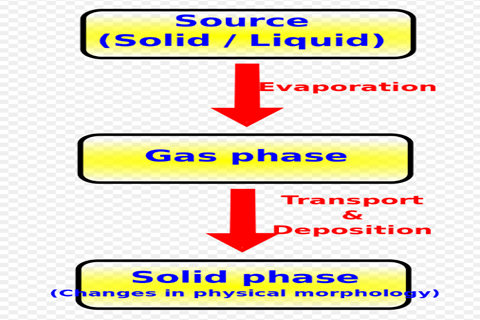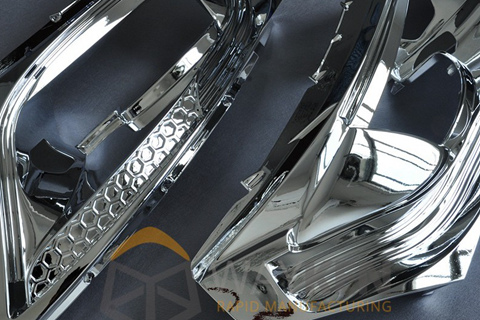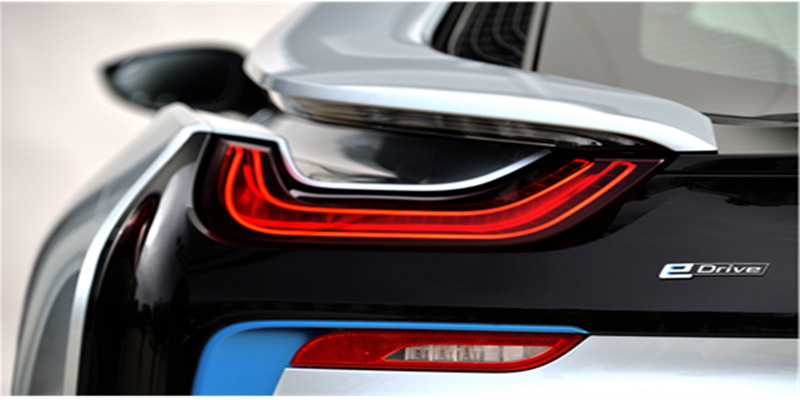Posted on Sept 3rd, 2019| By Hazel, WayKen Project Manager
PVD Aluminum metalized parts are quite familiar to see from cars, buses, trucks, and even bicycles running on the road every day. Those parts can be car logos, lenses, optics, touch screens, mirrors, and some other exterior and interior decorative parts. They look like aluminum but when we hold it, we will find they are not metal actually. Most of them are plastics in fact.
In this article, we are going to talk about the applications of PVD Aluminum Metalized finish in automotive industry.
First of all, what PVD Aluminum Metalizing is?
PVD (Physical Vapor Deposition) are sputtering and evaporation processes where materials like aluminum or hard alloys go from a condensed phase to a vapor phase and then condense as a thin film on the object to coat, which is also called Vacuum Metalizing.

PVD Aluminum Metalized Finish refers to process of coating aluminum to a non-metallic substrate through evaporation. The substrate has to be or to be made vacuum-compatible. The most common are tool materials, steels, glass, brass, zinc and ABS and polycarbonate plastic.
PVD aluminum coating will be a good option for applications requiring very thin functional coatings. PVD coating process deposited a layer of high density material
which is only a few microns thick. Once applied, the coating is hardly possible to remove and does not wear itself off.
Then, what can PVD Aluminum metalized finish do for Vehicle Parts?
In Automotive industry, PVD Aluminum metalizing use has grown in recent years for some reasons, including the following:
- It provides the aesthetic appearance of metal parts while lowering the cost;
- It’s safer than other processes. Vacuum metalizing does not require the dangerous chemicals mixing.
- The purer process reduces the risks of chemicals in the part causing issues for people.
- It offers higher levels of resilience than metal coating in the other forms.
- It gives beneficial properties to the base material, such as high wear resistance, high hardness at high operating temperatures, high oxidation resistance, low friction, anti-sticking, high scratch resistance, etc…

In Automotive industry, almost all manufacturers, especially those auto manufacturers, will rack their wits about how to achieve ideal status between higher strength and lighter weight for their vehicle products. Therefore, aluminum has become a good catch instead of other metals for them due to its properties of good strength and light weight. Moreover, with the technology developing, when vacuum metalizing appeared, manufactures quickly got the idea to apply it in vehicles – PVD Aluminum metalized finish on plastic parts to replace their metal versions.
An Example of Automotive Headlight Reflector at Prototyping Stage

Above is a pair of glossy reflectors made by Wayken. They are prototypes for optical tests, made of PC/ABS by CNC machined and PVD Aluminum Metalized.
The optical functions can be achieved by either their aluminum version or PC/ABS + PVD aluminum metalized version. What are the advantages of PC/ABS version?
- Regarding to the aesthetic effect, PVD AL metallization on plastics could have more brilliant mirror effect than mirror polished aluminum by hand crafts.
- Regarding to the weight, the density of PC/ABS is 1.160 g/cm^3 while the density of Aluminum is 2.7 g/cm^3. For same volume, the AL version will be more than 2 times heavier than the PC/ABS version. The PC/ABS version favors the trend of lighter weight for car producers.
- Regarding to the costs, aluminum surely costs higher than PC/ABS plastic. Besides, the heavier aluminum reflectors will cost higher on freight costs.
Besides lamp reflectors, PVD Aluminum metalized finish can also benefit for anything from luxury automotive trim to operational parts like exhaust pipes. If you are very interested in our special surface treatment services, there are more custom prototypes projects like this you can review.
Five FAQs
Question.1: What is the difference between PVD aluminum coating and other coating processes?
PVD is a dry coating process. Usually the coating is transferred to the substrate through the aid of a medium, for example a solvent. With PVD the aluminum vapor is generated, transferred in the gas phase and deposited as a coating directly to the substrate without use of a medium. PVD only needs electrical power and cooling facilities to operate.
Question.2: Can I achieve different surface ¬finishes by PVD aluminum metallization?
The PVD aluminum metallization closely follows the topology of the surface. No roughness is added or removed. Thus, the PVD finish depends upon the surface finish of the substrates. The polished or mirror surface will produce polished PVD aluminum metalized finishes; brushed or satin surfaces will produce satin or matt PVD aluminum metalized finishes. A polymer powder coating can be used as a pretreatment in order to provide a smooth glossy surface.
Question.3: Is it possible to remove PVD Aluminum Coatings?
Yes, there are de-coating processes available for removing most of PVD aluminum coatings. These processes remove only the coating layers while not affecting the majority of application substrates.
Question.4: Does PVD Aluminum Metalizing mask imperfections in the surface?
No. The process does not fill in or level out the surface. Surface imperfections will remain visible after PVD aluminum coating is applied. In fact, as PVD coatings in most cases have a high reflection, defects will become even better visible.
Question.5: Is it possible to mask certain areas on parts to prevent them from being coated?
Yes. PVD is a line-of-sight process. Therefore, it is possible to mask areas in order to prevent them from receiving coating deposits. Masking and substrate manipulation in the deposition process make it possible to coat the desired areas only.
Concludes
The PVD aluminum coating favors the trend of greener and lighter manufacturing. It can even be said that the PVD aluminum coating will take a place in the future of auto manufacturing.No matter what it refers to visual or functional requirements, we can match the real production surface finfishing on both plastic and metal custom machined parts.If you are interested to know more about PVD Aluminum metalized prototyping projects of Wayken, you can contact us by the email address — [email protected]. All inquiries from you will be appreciated, not only for a quote.





